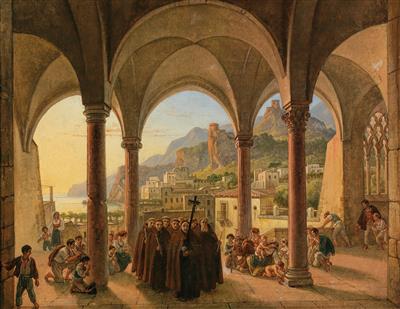Franz Ludwig Catel

(Berlin 1778–1856 Rome)
A View of Amalfi from the Vestibule of the Cathedral, signed, dated F. Catel Rome 1834, oil on canvas, 37 x 46.5 cm, framed
Provenance:
Former Helbig Collection, Dresden;
Private Collection Vienna.
Catalogued and illustrated in:
Andreas Stolzenburg, Der Landschafts- und Genremaler Franz Ludwig Catel (1778–1956), Casa di Goethe, Rome, 30 January - 22 April 2007, p. 98, ill. no. 35.
We are grateful to Dr. Andreas Stolzenburg for his scientific assistance and providing the catalogue entry for this lot.
In the summer of 1812, the Berlin landscape and genre painter Franz Ludwig Catel, who had been living in Rome since 1811, visited the charming coastal town of Amalfi as a travelling companion of the French archaeologist Aubin-Louis Millin (1759-1828). Motifs from this trip appear again and again in Catel‘s paintings, such as the famous grotto of the Capuchin convent of San Francesco or - as here - the view from the vestibule of the cathedral onto the square.
In the 1824 Kunstblatt, this motif is admired in detail for the first time: „The portico of the Camaldolese monastery near Salerno [sic; Amalfi Cathedral], through which one can see the lower lying city, together with the picturesque mountains and the strange peak of Mount St. Angelo towering above. The sun is on the left and glowing in the flood. A procession of monks enters through the columned hall, shining in the evening light; the devout crowd kneels on either side with their interesting costumes and expressions. In many smaller pictures Catel has depicted the domestic life, the rural pleasures and occupations of the inhabitants of these flourishing regions.“
Carl Seidel described the composition in 1826 and criticised the broad, but from today‘s point of view, extremely attractive brushwork, „the artist knows above all how to pick out his reproaches from the rich nature surrounding him, and to choose the most advantageous point of view each time. He has a peculiar clarity of light and air, and his brushwork is light and assertive, which stands out against the increasingly anxious painting of leaves and flowers in the landscape. The above-mentioned picture provides fitting proof of this. The background here is excellently kept, the archway is magically beautiful and yet so truly illuminated, the daylight falling on the floor is reflected in the vaults and then falls again pleasantly on the beautifully clear groups of people - the light truly plays around each individual figure. The staffage characteristically reflects the life of those regions; one sees processioning monks and next to them almost nothing but beggars. The spirit of humanity that has sunk into the gloomy monastery walls is clearly painted on the faces of the rather large figures, and the expressions of intolerance in the faces of the cross-bearer are particularly striking. The beggar folk with their crutches, bandages and rags are no less happily depicted in their mindless dullness, only the treatment here is too rough, and the heads are sometimes, as for example in the kneeling man, neglected. If only the splendid master would let himself go formally at times, and not indulge in too broad a manner.“
The present small-format picture, which repeats the early motif, was painted in 1834 according to the artist‘s own signature and date, and can be identified with the one mentioned in the 1835 Kunstblatt: „“The portico of the Camaldolese monastery near Salerno [sic; Amalfi Cathedral], through which one can see the lower lying city, together with the picturesque mountains and the strange peak of Mount St. Angelo towering above. The sun is on the left and glowing in the flood. A procession of monks enters through the columned hall, shining in the evening light; the devout crowd kneels on either side with their interesting costumes and expressions.“
Andreas Stolzenburg
Specialist: Mag. Dimitra Reimüller
 Mag. Dimitra Reimüller
Mag. Dimitra Reimüller
+43-1-515 60-355
19c.paintings@dorotheum.at
07.06.2021 - 16:00
- Estimate:
-
EUR 40,000.- to EUR 50,000.-
Franz Ludwig Catel
(Berlin 1778–1856 Rome)
A View of Amalfi from the Vestibule of the Cathedral, signed, dated F. Catel Rome 1834, oil on canvas, 37 x 46.5 cm, framed
Provenance:
Former Helbig Collection, Dresden;
Private Collection Vienna.
Catalogued and illustrated in:
Andreas Stolzenburg, Der Landschafts- und Genremaler Franz Ludwig Catel (1778–1956), Casa di Goethe, Rome, 30 January - 22 April 2007, p. 98, ill. no. 35.
We are grateful to Dr. Andreas Stolzenburg for his scientific assistance and providing the catalogue entry for this lot.
In the summer of 1812, the Berlin landscape and genre painter Franz Ludwig Catel, who had been living in Rome since 1811, visited the charming coastal town of Amalfi as a travelling companion of the French archaeologist Aubin-Louis Millin (1759-1828). Motifs from this trip appear again and again in Catel‘s paintings, such as the famous grotto of the Capuchin convent of San Francesco or - as here - the view from the vestibule of the cathedral onto the square.
In the 1824 Kunstblatt, this motif is admired in detail for the first time: „The portico of the Camaldolese monastery near Salerno [sic; Amalfi Cathedral], through which one can see the lower lying city, together with the picturesque mountains and the strange peak of Mount St. Angelo towering above. The sun is on the left and glowing in the flood. A procession of monks enters through the columned hall, shining in the evening light; the devout crowd kneels on either side with their interesting costumes and expressions. In many smaller pictures Catel has depicted the domestic life, the rural pleasures and occupations of the inhabitants of these flourishing regions.“
Carl Seidel described the composition in 1826 and criticised the broad, but from today‘s point of view, extremely attractive brushwork, „the artist knows above all how to pick out his reproaches from the rich nature surrounding him, and to choose the most advantageous point of view each time. He has a peculiar clarity of light and air, and his brushwork is light and assertive, which stands out against the increasingly anxious painting of leaves and flowers in the landscape. The above-mentioned picture provides fitting proof of this. The background here is excellently kept, the archway is magically beautiful and yet so truly illuminated, the daylight falling on the floor is reflected in the vaults and then falls again pleasantly on the beautifully clear groups of people - the light truly plays around each individual figure. The staffage characteristically reflects the life of those regions; one sees processioning monks and next to them almost nothing but beggars. The spirit of humanity that has sunk into the gloomy monastery walls is clearly painted on the faces of the rather large figures, and the expressions of intolerance in the faces of the cross-bearer are particularly striking. The beggar folk with their crutches, bandages and rags are no less happily depicted in their mindless dullness, only the treatment here is too rough, and the heads are sometimes, as for example in the kneeling man, neglected. If only the splendid master would let himself go formally at times, and not indulge in too broad a manner.“
The present small-format picture, which repeats the early motif, was painted in 1834 according to the artist‘s own signature and date, and can be identified with the one mentioned in the 1835 Kunstblatt: „“The portico of the Camaldolese monastery near Salerno [sic; Amalfi Cathedral], through which one can see the lower lying city, together with the picturesque mountains and the strange peak of Mount St. Angelo towering above. The sun is on the left and glowing in the flood. A procession of monks enters through the columned hall, shining in the evening light; the devout crowd kneels on either side with their interesting costumes and expressions.“
Andreas Stolzenburg
Specialist: Mag. Dimitra Reimüller
 Mag. Dimitra Reimüller
Mag. Dimitra Reimüller
+43-1-515 60-355
19c.paintings@dorotheum.at
|
Buyers hotline
Mon.-Fri.: 10.00am - 5.00pm
kundendienst@dorotheum.at +43 1 515 60 200 |
| Auction: | 19th Century Paintings |
| Auction type: | Saleroom auction with Live Bidding |
| Date: | 07.06.2021 - 16:00 |
| Location: | Vienna | Palais Dorotheum |
| Exhibition: | 29.05. - 07.06.2021 |
